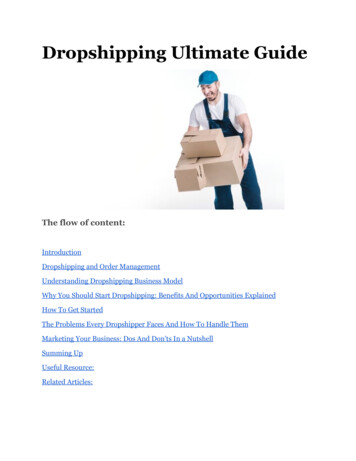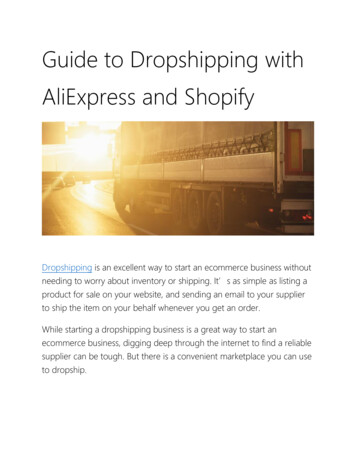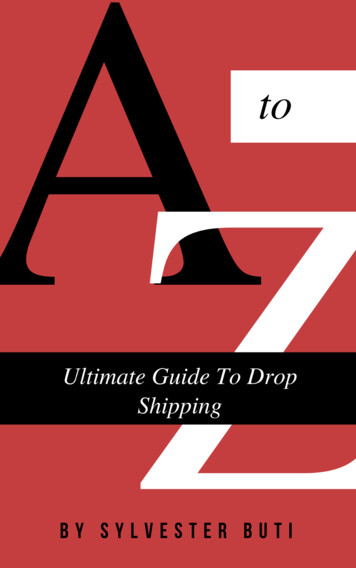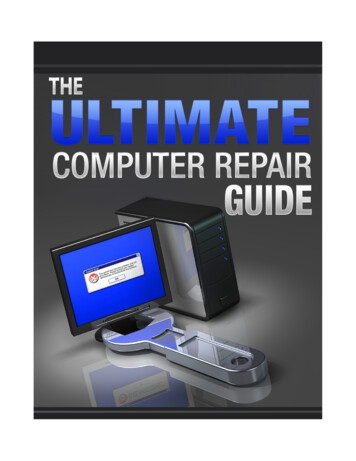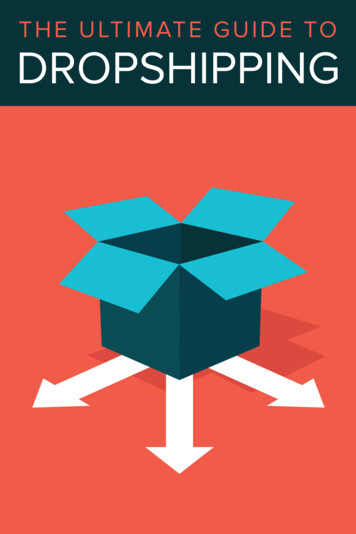
Transcription
T H E U LT I M AT E G U I D E TODROPSHIPPING
What’s in this guide?The phrase “dropshipping” evokes a widearray of responses. Some believe it’s a greatway to get started with ecommerce. Othersimmediately discount it, having heard abouttoo many dropshipping related scams andpromise-the-moon information products. Withso many rumors and so much misinformationfloating around, it’s hard to know what tobelieve — which is why we wrote this guide.This is the most detailed and thorough guideThis is the mostto dropshipping you’ll find anywhere. Nodetailed andscams or sales pitches here — just thethorough guide tohonest truth, written by folks who have useddropshipping you’lldropshipping to create large, successfulfind anywhere.ecommerce businesses. We won’t be tellingyou what we think might work, we’ll tell youwhat we know will work based on real-world experience.This guide will teach you everything you need to know to get your owndropshipping business off the ground while avoiding the costly mistakes thatcan kill new dropshipping ventures. We’ll discuss everything from dropshippingbasics to operating a dropshipping business and dealing with some of theproblems that arise.The Ultimate Guide to Dropshipping1
Understanding DropshippingDropshipping is a retail fulfillment method where a store doesn't keep theproducts it sells in stock. Instead, when a store sells a product, it purchases theitem from a third party and has it shipped directly to the customer. As a result,the merchant never sees or handles the product.The biggest difference between dropshipping and the standard retail model isthat the selling merchant doesn't stock or own inventory. Instead, the merchantpurchases inventory as needed from a third party – usually a wholesaler ormanufacturer – to fulfill orders.This unique model has a number of benefits and drawbacks:BenefBenefitsitsLESS CCAPITAPITALAL IS REQUIRED – Probably the biggest advantage to dropshippingis that it's possible to launch an ecommerce store without having to investthousands of dollars in inventory up front. Traditionally, retailers have had to tieup huge amounts of capital purchasing inventory.With the dropshipping model, you don't have to purchase a product unless youalready made the sale and have been paid by the customer. Without major upfront inventory investments, it's possible to start a successful dropshippingbusiness with very little money.EASEASYYTTOO GET SSTTARARTEDTED – Running an ecommerce business is much easierwhen you don't have to deal with physical products. With dropshipping, youdon't have to worry about:2The Ultimate Guide to Dropshipping
Managing or paying for a warehousePacking and shipping your ordersTracking inventory for accounting reasonsHandling returns and inbound shipmentsContinually ordering products and managing stock levelLOW OOVERHEADVERHEAD – Because you don't have to deal with purchasing inventoryor managing a warehouse, your overhead expenses are quite low. In fact, manysuccessful dropshipping businesses are run from a home office with a laptop forless than 100 per month. As you grow, these expenses will likely increase butwill still be low compared to those of traditional brick-and-mortar businesses.FLEXIBLE LLOCOCATIONATION – A dropshipping business can be run from just aboutanywhere with an internet connection. As long as you can communicate withsuppliers and customers easily, you can run and manage your business.WIDE SELECTION OF PRODUCTPRODUCTSS – Because you don't have to pre-purchasethe items you sell, you can offer an array of products to your potentialcustomers. If suppliers stock an item, you can list if for sale on your website at noadditional cost.EASEASYYTTOO SCSCALEALE – With a traditional business, if you receive three times asmuch business you'll usually need to do three times as much work. Byleveraging dropshipping suppliers, most of the work to process additionalorders will be borne by the suppliers, allowing you to expand with fewergrowing pains and less incremental work. Sales growth will always bringadditional work – especially related to customer service – but business thatutilize dropshipping scale particularly well relative to traditional ecommercebusinesses.All these benefits make dropshipping a very attractive model to both beginningand established merchants. Unfortunately, dropshipping isn't all roses andrainbows. All this convenience and flexibility comes at a price.DisadDisadvvanantagestagesLOW MARGINS – Low margins are the biggest disadvantage to operating in ahighly competitive dropshipping niche. Because it's so easy to get started – andthe overhead costs are so minimal – many merchants will set up shop and sellitems at rock-bottom prices in an attempt to grow revenue. They've invested soThe Ultimate Guide to Dropshipping3
little in getting the business started so they can afford to operate on minusculemargins.True, these merchants often have low-quality websites and poor (if any)customer service. But that won't stop customers from comparing their prices toyours. This increase in cutthroat competition will quickly destroy the profitmargin in a niche. Fortunately, you can do a lot to mitigate this problem byselecting a niche that's well suited for dropshipping. We'll discuss this more inChapter 4.INVENTINVENTORORYY ISSUES – If you stock all your own items, it's relatively simple tokeep track of which items are in and out of stock. But when you're sourcing frommultiple warehouses, which are also fulfilling orders for other merchants,inventory changes on a daily basis. While there are ways you can better syncyour store's inventory with your suppliers', these solutions don't always workseamlessly, and suppliers don't always support the technology required.SHIPPING COMPLEXITIES – If you work with multiple suppliers – as most dropshippers do – the products on your website will be sourced through a numberof different drop shippers. This complicates your shipping costs.Let's say a customer places an order for three items, all of which are availableonly from separate suppliers. You'll incur three separate shipping charges forsending each item to the customer, but it's probably not wise to pass this chargealong to the customer, as they'll think you're grossly overcharging for shipping!And even if you did want to pass these charges along, automating thesecalculations can be difficult.SUPPLIER ERRORS – Have you ever been blamed for something that wasn'tyour fault, but you had to accept responsibility for the mistake anyway?Even the best dropshipping suppliers make mistakes fulfilling orders – mistakesfor which you have to take responsibility and apologize. And mediocre and lowquality suppliers will cause endless frustration with missing items, botchedshipments and low-quality packing, which can damage your business'sreputation.4The Ultimate Guide to Dropshipping
Is It WWorthorth It?As we initially warned, dropshipping isn't a perfect, stress-free way to build asuccessful business. The model has some definite advantages but comes with anumber of built-in complexities and problems you'll need to be able to address.We'll be examining these problems – and how to best address them – in futurechapters. The good news is that with some careful planning and consideration,most of these problems can be resolved and need not prevent you frombuilding a thriving, profitable dropshipping business.The Ultimate Guide to Dropshipping5
The Supply Chain & FulfillmentProcess“Supply chain” is a fancy term describing the path a product takes to go fromconception through manufacturing and finally into the hands of a customer. If wewere talking with hard-core supplier chain gurus, they'd insist a product's supplychain reaches all the way to the mining of the materials (like oil and rubber) usedto manufacture an item. But that’s a little intense.For the purposes of this guide, we don't need to get quite that detailed. Yousimply need to understand the three most applicable players that make up thedropshipping supply chain: manufacturers, wholesalers and retailers.So here we go:MANUFMANUFACTURERSACTURERS – Manufacturers create the product and most do not selldirectly to the public. Instead, they sell in bulk to wholesalers and retailers.Buying directly from the manufacturer is the cheapest way to purchase productsfor resale, but most have minimum purchase requirements you'll need to meet.You'll also need to stock and then re-ship the products when selling them tocustomers. For these reasons, it's often easier to buy directly from a wholesaler.WHOLESWHOLESALERSALERS – Wholesalers buy products in bulk from manufacturers, markthem up slightly and then sell them to retailers for resale to the public. If they dohave purchasing minimums, they're generally much lower than those requiredby a manufacturer.Wholesalers will usually stock products from dozens – if not hundreds – ofmanufacturers and tend to operate in a specific industry or niche. Most arestrictly wholesaler operators, meaning they sell only to retailers and not directlyto the general public.6The Ultimate Guide to Dropshipping
RETRETAILERSAILERS – A retailer is anyone who sells products directly to the public at amarkup. If you run a business that fulfills your orders via dropshipping suppliers,you're a retailer.DropshippinDropshippingg Is a ServiceService,,Not a RoleYou'll notice that “dropshipper” isn't one of the players listed in the supply chain.Why? Because any of the three – manufacturer, wholesaler or retailer – can actas a drop shipper!If a manufacturer is willing to ship its products directly to your customer, it is“dropshipping” on your behalf. Similarly, a retail merchant can offer to dropship,although its pricing won't be as competitive as a wholesaler's because it isn'tbuying directly from the manufacturer.Just because someone claims to be a “dropshipper” does not mean you'regetting wholesale pricing. It simply means the company will ship products onyour behalf. To get the best pricing, you want to make sure you're workingdirectly with a legitimate wholesaler or manufacturer, a topic we'll be covering indepth in the next chapter.DropshippinDropshippingg in Action:The Order ProcessNow that you understand the players involved, let's take a look at how a dropshipped order gets processed. To illustrate, we'll follow an order placed with ourtheoretical store, Phone Outlet, an online merchant that specializes inaccessories for smart phones. Phone Outlet dropships all of its products directlyfrom a wholesaler we'll call Wholesale Accessories.Here's a sample of how the entire ordering process might look:The Ultimate Guide to Dropshipping7
Step 1 – Customer Places Order With Phone OutletMr. Allen needs a case for his new smartphone andplaces an order via Phone Outlet's online store. Oncethe order is approved, a few things happen: Phone Outlet and Mr. Allen get an email confirmation(likely identical) of the new order that is automaticallygenerated by the store software. Mr. Allen's payment is captured during the checkout process and will beautomatically deposited into Phone Outlet's bank account.Step 2 – Phone Accessory Outlet Places the Order With ItsSupplierThis step is usually as simple as Phone Outlet forwardingthe email order confirmation to a sales representative atWholesale Accessories. Wholesale Accessories hasPhone Outlet's credit card on file and will bill it for thewholesale price of the goods, including any shipping orprocessing fees.NONOTE:TE: Some sophisticated dropshippers will support automatic XML (acommon format for inventory files) order uploading or the ability to place theorder manually online, but email is the most common way to place orders withdropshipping suppliers because it's universal and easy to use.Step 3 – Wholesale Accessories Ships the OrderAssuming the item is in stock and the wholesaler wasable to successfully charge Phone Outlet's card,Wholesale Accessories will box up the order and ship itdirectly to the customer. Though the shipment comesfrom Wholesale Accessories, Phone Outlet's name andaddress will appear on the return address label and itslogo will appear on the invoice and packing slip. Oncethe shipment has been finalized, Wholesale Accessories will email an invoiceand a tracking number to Phone Outlet.8The Ultimate Guide to Dropshipping
NONOTE:TE: The turnaround time on dropshipped orders is often faster than you'dthink. Most quality suppliers will be able to get an order out the door in a fewhours, allowing merchants to advertise same-day shipping even when they areusing a dropshipping supplier.Step 4 – Phone Outlet Alerts the Customer of ShipmentOnce the tracking number is received, Phone Outlet willsend the tracking information to the customer, likely usingan email interface that's built in to the online storeinterface. With the order shipped, the payment collectedand the customer notified, the order and fulfillmentprocess is complete. Phone Outlet's profit (or loss) is thedifference between what it charged Mr. Allen and what itpaid Wholesale Accessories.Dropshippers Are InInvisiblevisibleDespite its critical role in the ordering and fulfillment process, the dropshipper iscompletely invisible to the end customer. When the package is received, onlyPhone Outlet's return address and logo will be on the shipment. If Mr. Allen'sreceives the wrong case, he would contact Phone Outlet, which would thencoordinate behind the scenes with Wholesale Accessories to get the right itemsent out.The dropshipping wholesaler doesn't exist to the end customer. Its soleresponsibility is to stock and ship products. Everything else – marketing, websitedevelopment, customer service, etc. – is the responsibility of the merchant.The Ultimate Guide to Dropshipping9
Finding and Working With SuppliersBefore searching for suppliers, it's critical to know how to differentiate betweenlegitimate wholesale suppliers and retail stores posing as wholesale supplie
This guide will teach you everything you need to know to get your own dropshipping business off the ground while avoiding the costly mistakes that can kill new dropshipping ventures. We’ll discuss everything from dropshipping basics to operating a dropshipping business and dealing with some of the problems that arise.
